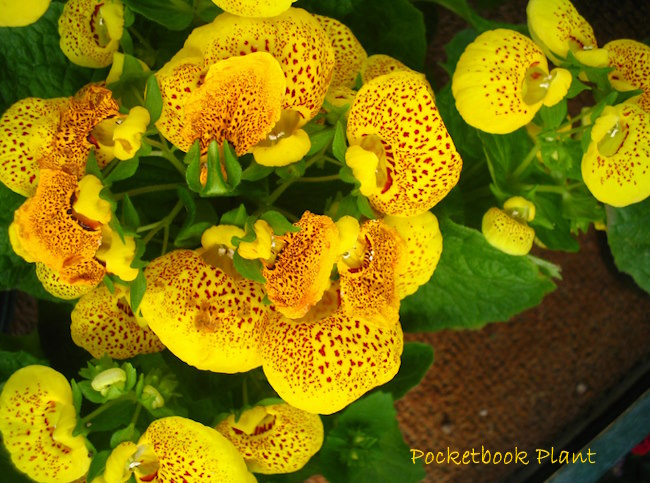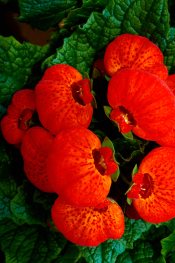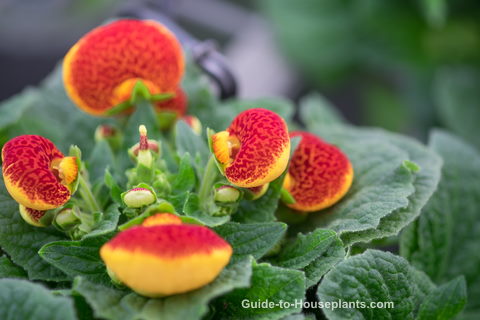Pocketbook Plant Care
Pocketbook Plant gets its name from its puffy, brightly colored flowers that look like pouches or slippers. Other common names for this unusual-looking plant are Slipper Flower and Slipperwort.
These one-time popular plants seem to have fallen out of favor in recent years, but I don't know why. Although they are temporary houseplants, they're eye-catching and fun to have around. Discover what light, water, humidity and temperature pocketbooks prefer.
 Photo credit: JessieEldora / istockphoto
Photo credit: JessieEldora / istockphotoGet to Know Calceolaria
Known by the botanical name Calceolaria x herbeohybrida, pocketbook plants are hybrids with origins from Mexico and South America.
Clusters of captivating, pouch-shaped blooms grow on tall stems above soft, green leaves. Each flower is about 2-inches wide (5 cm), but dozens may bloom on each flower stem. The heart-shaped leaves are deeply veined with scalloped edges, and reach 6 in (15 cm) long.

How tall does pocketbook plant get? Grown plants will reach a height of 6 to 12 in (15 to 30 cm).
Although their blooming time is short-lived, these unusual house plants are well-worth having around for their cheery spotted flowers. And why buy just one? Display two or three plants together in contrasting colors. Their vibrant blooms also look dramatic beside tropical foliage plants, dressing up a Boston fern or maidenhair fern for a while.
Choose a plant with plenty of unopened buds and you'll enjoy several weeks of blooms. Many flower colors are available -- yellow, white, orange, red, maroon or copper, usually with red, purple or brown spots. Popular cultivars include 'Anytime Mixed' and 'Gold Fever'.
These hybrid plants are available in florists' shops and garden centers in spring, their natural bloom time.
You won't need to repot your new plant. In fact, you shouldn't repot any houseplant that's in bloom. Why? Repotting is stressful for a plant, and it may drop its flowers and flower buds. If you want to cover up a plain nursery pot, drop it into a cachepot -- a decorative container without drainage holes. It's a good idea to put small rocks in the bottom of the cachepot to keep the inner pot above the drainage water.
Pocketbook Plant Problems, Solutions and Answers
Brown, scorched leaves may be caused by exposure to hot, direct sunlight. Find a spot for your plant that is free from drafts and direct sun, both of which will scorch its soft leaves.
Something bugging your houseplant? Check over the leaves and stems for aphids. These tiny pests are attracted to the soft foliage of plants. Treat an infestation right away -- you don't want insects to move on to your other houseplants.
How long does it last? Keep pocketbook cool and moist and you'll enjoy its masses of blooms for several weeks. Discard it after flowering has finished. It's an annual and won't bloom again.

Pocketbook Plant Care Tips
Light: Bright light. Shade it from hot, direct sunlight which can scorch its leaves.
Water: Keep soil lightly moist at all times. This plant may not recover if the soil is allowed to dry out. Use a pot with drainage holes; water thoroughly to wet all the roots, then empty drainage tray. Avoid watering over the crown of the plant because it may rot.
Humidity: Requires moist air; aim to keep the relative humidity above 50%. Stand the pot on a tray of wet pebbles to increase the humidity around the plant. Don't mist because water may damage the soft foliage.
Temperature: Cool 45-50°F/7-10°C at night; 55-60°F/13-16°C during the day
Soil: Peat moss-based potting mix with added perlite for good drainage. African violet potting mix is ideal for this houseplant.
Fertilizer: Not needed; this Calceolaria hybrid blooms for a season then can be discarded.
Propagation: Sow seeds anytime. These hybrids are slow-growing, though. You'll wait 4-5 months for pocketbook plants to bloom.


